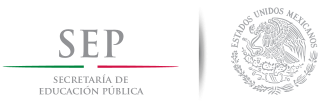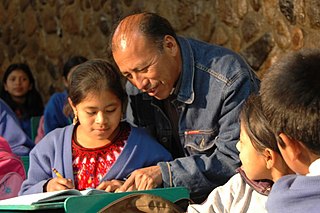Educational assessment or educational evaluation is the systematic process of documenting and using empirical data on the knowledge, skill, attitudes, and beliefs to refine programs and improve student learning. Assessment data can be obtained from directly examining student work to assess the achievement of learning outcomes or can be based on data from which one can make inferences about learning. Assessment is often used interchangeably with test, but not limited to tests. Assessment can focus on the individual learner, the learning community, a course, an academic program, the institution, or the educational system as a whole. The word 'assessment' came into use in an educational context after the Second World War.

In education, a curriculum is broadly defined as the totality of student experiences that occur in the educational process. The term often refers specifically to a planned sequence of instruction, or to a view of the student's experiences in terms of the educator's or school's instructional goals. In a 2003 study, Reys, Reys, Lapan, Holliday, and Wasman refer to curriculum as a set of learning goals articulated across grades that outline the intended mathematics content and process goals at particular points in time throughout the K–12 school program. Curriculum may incorporate the planned interaction of pupils with instructional content, materials, resources, and processes for evaluating the attainment of educational objectives. Curriculum is split into several categories: the explicit, the implicit, the excluded, and the extracurricular.

Bernardino de Sahagún was a Franciscan friar, missionary priest and pioneering ethnographer who participated in the Catholic evangelization of colonial New Spain. Born in Sahagún, Spain, in 1499, he journeyed to New Spain in 1529. He learned Nahuatl and spent more than 50 years in the study of Aztec beliefs, culture and history. Though he was primarily devoted to his missionary task, his extraordinary work documenting indigenous worldview and culture has earned him the title as “the first anthropologist." He also contributed to the description of the Aztec language Nahuatl. He translated the Psalms, the Gospels, and a catechism into Nahuatl.

Education in Mexico has a long history. The Royal and Pontifical University of Mexico was founded by royal decree in 1551, a few months after the National University of San Marcos in Lima. By comparison, Harvard College, the oldest in the USA, was founded in 1636 and the oldest Canadian University, Université Laval dates from 1663. Education in Mexico was, until the twentieth-century, largely confined to males from the urban and aristocratic elite and under the auspices of the Roman Catholic Church in Mexico.
Founded in 1920, The National Council of Teachers of Mathematics (NCTM) is the world's largest mathematics education organization.
Project-based learning (PBL) is a student-centered pedagogy that involves a dynamic classroom approach in which it is believed that students acquire a deeper knowledge through active exploration of real-world challenges and problems. Students learn about a subject by working for an extended period of time to investigate and respond to a complex question, challenge, or problem. It is a style of active learning and inquiry-based learning. PBL contrasts with paper-based, rote memorization, or teacher-led instruction that presents established facts or portrays a smooth path to knowledge by instead posing questions, problems or scenarios.
The Pasadena Unified School District is a unified school district that is responsible for the schools of Pasadena, California. As of 2014, it has four high schools, five middle schools, three K–8 schools and 15 K–5 elementary schools. The number of elementary schools was reduced from 18 at the end of the 2010–11 school year. The district also serves the city of Sierra Madre and the unincorporated community of Altadena.
Technological literacy is the ability to use, manage, understand, and assess technology. Technological literacy is related to digital literacy in that when an individual is proficient in using computers and other digital devices to access the Internet, digital literacy gives them the ability to use the Internet to discover, review, evaluate, create, and use information via various digital platforms, such as web browsers, databases, online journals, magazines, newspapers, blogs, and social media sites.
The Standardized Testing and Reporting (STAR) Program measures performance of students undergoing primary and secondary education in California. It was replaced in late 2013-early 2014 with the California Assessment of Student Performance and Progress (CAASPP), also known as the Measurement of Academic Performance and Progress (MAPP).
A controversy in the US state of California concerning the portrayal of Hinduism in history textbooks began in 2005. The Texas-based Vedic Foundation (VF) and the American Hindu Education Foundation (HEF), complained to California's Curriculum Commission, arguing that the coverage in sixth grade history textbooks of Indian history and Hinduism was biased against Hinduism; points of contention included a textbook's portrayal of the caste system, the Indo-Aryan migration theory, and the status of women in Indian society.
Dual language is a form of education in which students are taught literacy and content in two languages. Most dual language programs in the United States teach in English and Spanish, but programs increasingly use a partner language other than Spanish, such as Arabic, Chinese, French, Hawaiian, Japanese, or Korean. Dual language programs use the partner language for at least half of the instructional day in the elementary years.
An open-source curriculum (OSC) is an online instructional resource that can be freely used, distributed and modified. OSC is based on the open-source practice of creating products or software that opens up access to source materials or codes. Applied to education, this process invites feedback and participation from developers, educators, government officials, students and parents and empowers them to exchange ideas, improve best practices and create world-class curricula. These "development" communities can form ad-hoc, within the same subject area or around a common student need, and allow for a variety of editing and workflow structures.

Abraham Lincoln High School, is an urban public high school in San Diego, California, United States. It is part of the San Diego Unified School District. It serves approximately 2100-2700 students in grades 9–12 in the K-12 education system. It is located in the Lincoln Park neighborhood of Southeast San Diego, part of the Encanto neighborhoods. It was named after President Abraham Lincoln.
The Alameda Science and Technology Institute (ASTI) is an early college high school in Alameda, California, United States.

Indigenous education specifically focuses on teaching Indigenous knowledge, models, methods, and content within formal or non-formal educational systems. The growing recognition and use of Indigenous education methods can be a response to the erosion and loss of Indigenous knowledge through the processes of colonialism, globalization, and modernity. Indigenous communities are able to "reclaim and revalue their languages and [traditions], and in so doing, improve the educational success of Indigenous students", thus ensuring their survival as a culture.
The California mission clash of cultures occurred at the Spanish Missions in California during the Spanish Las Californias-New Spain and Mexican Alta California eras of control, with lasting consequences after American statehood. The Missions were religious outposts established by Spanish Catholic Franciscans from 1769 to 1823 for the purpose of protecting Spain's territory by settlements and converting the Californian Native Americans to a Christian religion.
Differentiated instruction and assessment, also known as differentiated learning or, in education, simply, differentiation, is a framework or philosophy for effective teaching that involves providing all students within their diverse classroom community of learners a range of different avenues for understanding new information in terms of: acquiring content; processing, constructing, or making sense of ideas; and developing teaching materials and assessment measures so that all students within a classroom can learn effectively, regardless of differences in ability. Students vary in culture, socioeconomic status, language, gender, motivation, ability/disability, personal interests and more, and teachers must be aware of these varieties as they plan curricula. By considering varied learning needs, teachers can develop personalized instruction so that all children in the classroom can learn effectively. Differentiated classrooms have also been described as ones that respond to student variety in readiness levels, interests and learning profiles. It is a classroom that includes all students and can be successful. To do this, a teacher sets different expectations for task completion for students based upon their individual needs.

The California Mathematics Project (CMP) is a K–16 network in California, United States, dedicated to providing students a rich, rigorous, and coherent mathematics curriculum taught by competent and confident mathematics teachers who foster all students’ proficiency in mathematics—achieving equity in quality.

An elementary school is the main point of delivery of primary education in the United States, for children between the ages of 6–11 and coming between pre-kindergarten and secondary education.

Intercultural bilingual education in Guatemala was begun as part of a 20th-century educational reform effort intended to promote the country's cultural diversity. The programs merge Mayan language and culture with Spanish language and Ladino culture, a shift from the assimilation policy of educational programs promoting Spanish literacy which reduce the use of indigenous languages. During the 20th century, education reform evolved from castilianization and the 1965 Bilingual Castilianization Program to the 1980 National Bilingual Education Project. Each program aimed to increase Spanish fluency. In 1985, the Constitution legalized bilingual education and the Ministry of Education formed the Programa Nacional de Educación Bilingüe (PRONEBI). PRONEBI developed from the 1980–1984 National Bilingual Education Project, and aimed to provide bilingual education for rural indigenous children.







